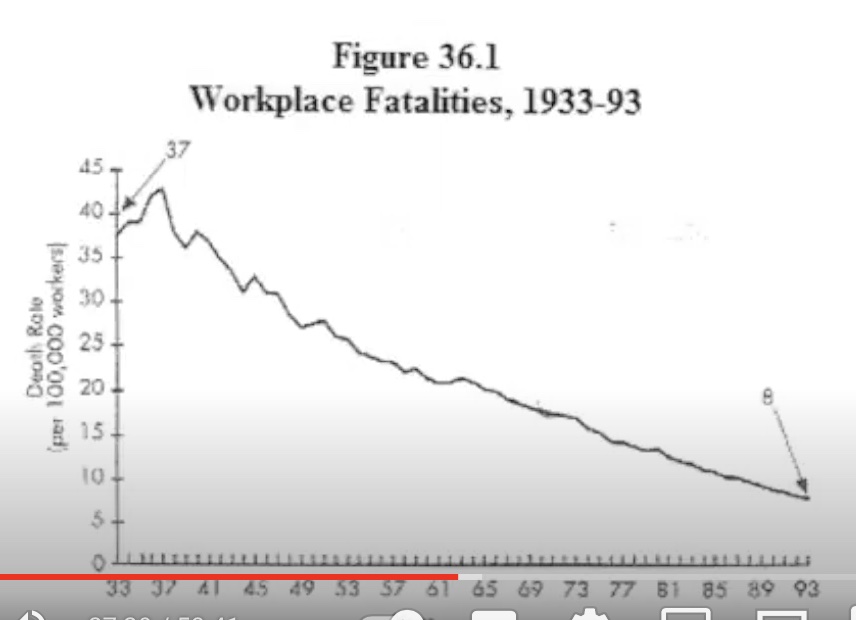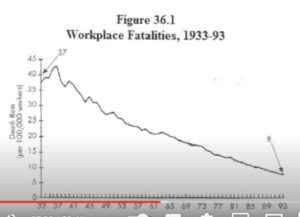

Here’s a graph of workplace fatalities in the United States from 1933 to 1993. Without Googling, Binging, or DuckDuckGoing, figure out, from the graph, when the United States government started the Occupational Safety and Health Administration (OSHA.)
Please keep your answer to yourself.
Bonus question that you’re encouraged to share your answer to:
Why were workplace fatalities falling? [HINT: What was happening to workers’ real income through this whole period?]

READER COMMENTS
Garrett
Jun 8 2022 at 11:20pm
I’d love to see the same exercise done with US life expectancy or some other measure of health and the year of the Pure Food and Drug Act
David Henderson
Jun 8 2022 at 11:33pm
That would be interesting.
Jared
Jun 9 2022 at 5:10pm
Here’s the graph: https://www.statista.com/statistics/1040079/life-expectancy-united-states-all-time/
robc
Jun 9 2022 at 5:37pm
Unrelated to the topic at hand, but it is interesting to see the huge dip due the civil war, another noticeable dip for WW1 and no dip for WW2.
Charley Hooper
Jun 9 2022 at 8:04pm
I cover this in my book, Should the FDA Reject Itself?
There was a trend break right about when the 1962 Kefauver-Harris amendments took effect and the U.S. life expectancy in 2020 was about 9.0 years less than the trend from 1900 through 1961 would suggest.
https://www.rejectfda.com/graphs-and-illustrations/
JFA
Jun 10 2022 at 6:46am
Mr. Hooper, from chapter 6 figure 1 it does look like there was a break in trend with new chemical entities, but the trend in life expectancy in chapter 6 figure 2 changed in what looks to be 1955 (7 years prior to 1962 Kefauver-Harris amendments).
Charley Hooper
Jun 13 2022 at 3:13pm
I see what you are saying.
I think it can be difficult to identify specific trend breaks in data that is variable by nature.
I’m not saying that X date is where the trend break occurred. What I’m saying, instead, is that the pre- and post-1962 trends are substantially different.
Felix
Jun 9 2022 at 9:34pm
I first noticed this with automobile safety statistics. I forget now what graph I used or how I found it; no doubt Google, maybe Wikipedia. Deaths or only injuries? Vehicle occupants only, or did it include pedestrians, bicyclists, and others? I do not remember. You could not tell from the graph when the federal government began regulating automobile safety.
Matthias
Jun 9 2022 at 5:06am
I like the idea of the exercise, but I don’t think it’s nearly as good of an argument as you seem to suggest.
For comparison, have a look at computing performance per dollar over time. It’s a pretty straight line and some suitable generalisation of Moore’s law extrapolates to the past before microchips and even transistors really, really well.
But those straight-ish line don’t mean that the invention of transistor or microchip were without consequences: being able to keep pushing an existing trend forward is not trivial.
In the case of OSHA, I agree that real wages increasing is probably the main driver, and that a safer work environment is something people will demand as one of the benefits in their (implicit) compensation package.
But: we can’t draw that conclusion from looking at this graph alone.
Daniel Kuehn
Jun 9 2022 at 9:04am
Right, these policy changes are always endogenous. We don’t just demand and can increasingly can afford public health and safety – that demand and ability to pay is working in the private sector too.
It would be interesting to see other safety measures too. Unions, private employers, and professional associations have long regulated the most serious risks in the most serious jobs. I wonder if you’d see the same smooth trend in other metrics. To me the smooth trend says a lot of this is structural: jobs have baseline risks that are improving at baseline rates and a lot of change comes from structural change in the distribution of jobs.
DeservingPorcupine
Jun 9 2022 at 3:59pm
Such a chart of computing performance would mean that no particular/individual change was that important on its own, though. In contrast, though, one would think that, if safety regs were important, that going from zero regs to some regs would indeed have an observable impact, no?
Raphael
Jun 9 2022 at 5:26am
I don’t think there is enough information in the graph alone. Am I not even allowed to know external information such as the end date of the Second World War?
Jon Murphy
Jun 9 2022 at 7:00am
I think rising real income matters, but also changing trade patterns. The US has generally been shifting toward more service industry jobs (which tend to be less dangerous).
Nathan LaBrecque
Jun 9 2022 at 9:53am
OSHA was not the first entity to enforce safe labor standards. What would happen if we looked at the time period before the Bureau of Labor Standards started?
Thomas Lee Hutcheson
Jun 9 2022 at 6:02pm
The graph is consistent with two hypotheses
a) OSHA did not cause any significant change in safety practices,
b) OSHA caused changes did not have any effect on fatalities.
Josh Lyle
Jun 10 2022 at 7:21am
Agreed. I have been in construction for 20+ years, and I have plenty of issues with OSHA, however overall they are a net good in my opinion. Outside of fatalities look at major and minor injuries that have been reduced over the years. Safety is something that has to be talked about every day, even doing that accidents still happen. OSHA helps ensure we are talking about safety every day.
Cort
Jun 9 2022 at 10:11pm
Contrary to popular beliefs OSHA was called for by businesses. They were sick of individual states enacting rules and wanted uniformity. Workplace safety was already an issue, business just wanted it standardized.
Chris
Jun 21 2022 at 11:25am
This exercise is useless without considering the impact of unions, technological advancements, changes in how many jobs are in ‘hard’ labor, non-OSHA workplace regulations, etc.
You may be right that OSHA has had a limited impact, but you may not be and this graph is not supporting an argument either way. Honestly, if I were to conjecture, I’d say that OSHA appears, by this graph, to have helped reduce the extremity of the peaks in number of deaths that are most apparent pre-1960. It would make sense that increased regulations would smooth out the graph by giving companies a framework for basic safety.
Comments are closed.